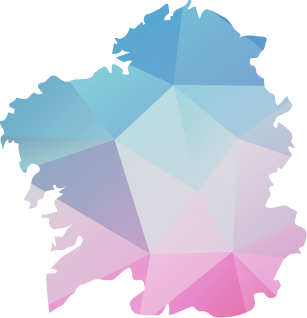Turismo de Galicia
-
Things to do
Way of St. James
Nature
Culture and heritage
Beaches and coast
Tourist trails
- Top ten: Ten unrivalled destinations
- The route of the camellia
- Tourist routes
- Pathways for discovering a country
- Walks to fall in love with
- Greenways
- Scenery at the wheel
- EuroVelo Galicia
- Beyond the Sunset
Gastronomy
Health tourism
PROMOTIONS TO ENJOY NOW
Cultural agenda
Will happen... View all
- Places to visit
-
Plan your trip
Build your journey
Practical information
- Start
- Things to do
-
Cultural agenda
- Way of St. James
- Galician Woodlands
- Experiencies in the midst of nature
- Magical Shrines
- Lighthouses and Wild Beaches
- Galicia Birding
- EuroVelo Galicia
- Hidden Heritage
- Marine Tourism
- Galicia Water Society
- Tourist routes
- The route of the camellia
- Scenery at the wheel
- Top ten: Ten unrivalled destinations
- Strolling Through Vineyards
- Pathways for discovering a country
- Walks to fall in love with
- Greenways
- Beyond the Sunset
- Galician springs
- Promotions to enjoy
- Cultural agenda
-
A miña viaxe
A MIÑA VIAXE
- Compartir
- Correo
- Imprimir
mailto:?subject=Content from Tourism of Galicia: Belén Artesanal en Movemento&body=I recommend you read the information Belén Artesanal en Movemento extracted from the Tourism of Galicia site on page https://www.turismo.gal/axenda-cultural/evento?langId=en_US%26nid=100836
Belén Artesanal en Movemento
The Valga Moving Artisanal Nativity Scene is one of the most spectacular Christmas events in Galicia, not only for its scale, as it includes more than traditional religious scenes, but also because it covers current affairs.
This has been one of the biggest and most eagerly-awaited social and cultural events of the year since 1995. It is a favourite of not just the locals but also thousands of people who come from all over Galicia to admire the hand-crafted figures representing all types of Christmas motifs and aspects of life and the latest goings-on in Valga and the rest of Spain. It is all made possible by the hard work and dedication of a group of locals in the Friends of the Valga Nativity Scene Cultural Association, which is supported by the town council.
The scenes on display are not the typical images of a desert and camels, which are also present, they also show traditional pig slaughtering, a woman milking a cow, and many other scenes from rural Galicia set in a landscape with different microclimates in a huge space. It is believed to be the largest moving nativity scene in Galicia and one of the biggest in Spain. There are just over 3,000 pieces, many of which move.
Alongside classic religious scenes such as the Three Wise Kings and the birth of the Baby Jesus, there are others which portray traditional practices in rural Galicia (pig slaughtering, the blacksmith, wheat harvest, wine and orujo making, the Santa Compaña myth) and local scenes from the area (processions held over the year in the area, the Festa de Mocidade festivities, the brick factory next to where the nativity scene is placed). The figures include illustrious individuals from the town of Valga (La Bella Otero and Xesús Ferro Couselo) and Galicia (Rosalía de Castro, Castelao, Camilo José Cela).
Current social and political events also have their place: the wedding of the Duchess of Alba, players from the Spanish national football team, election debates.
The figures and decorations are made from paper, plaster, modelling clay, wire, wood, and stone. The work is all done by hand. Everything in the nativity scene is made by hand and most of it is also recycled. For example, the motors that move the figures are used motors from windscreen wipers, electric toothbrushes, and similar items. This artisanal tradition is not a rejection of modern technology, as a computer and programming are used to recreate the different phases of the day and other effects (light, sounds, snow, thunder).



